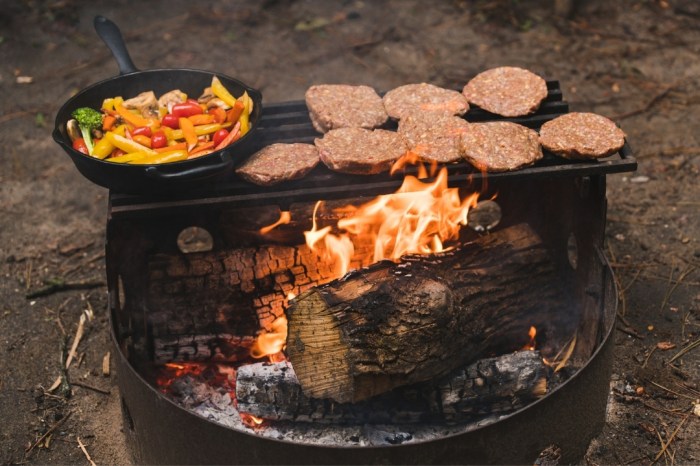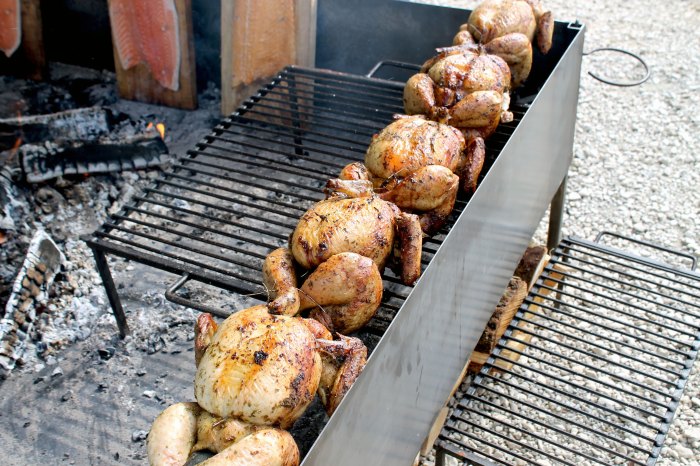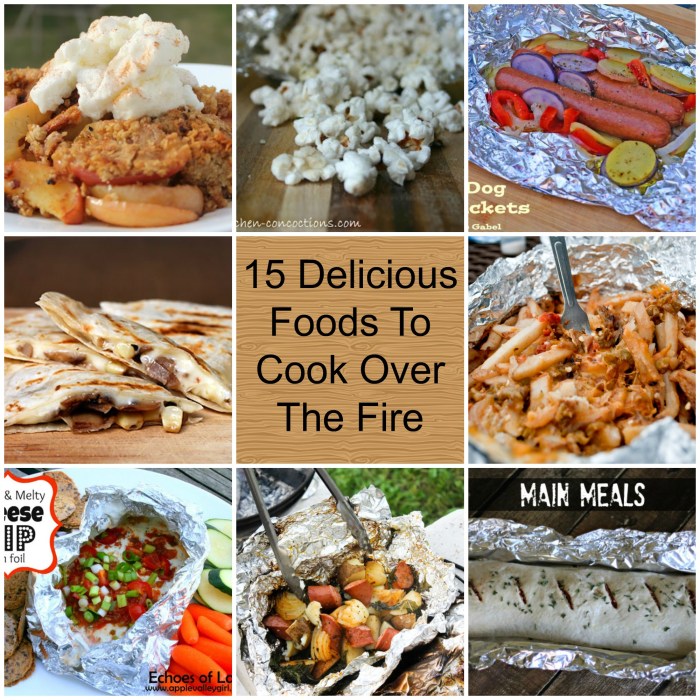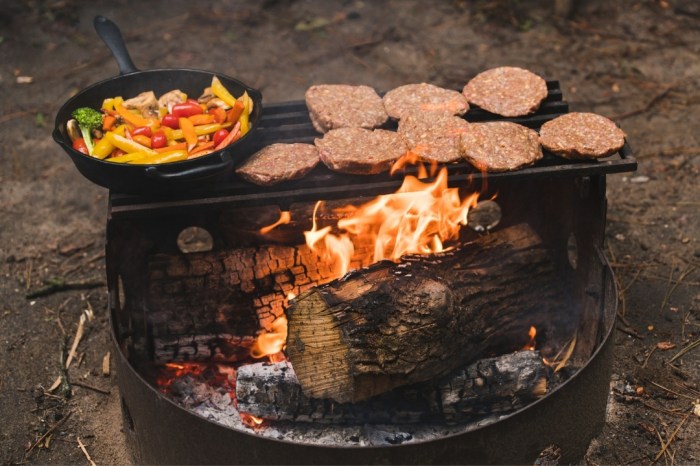
15 Delicious Campfire Foods: Fueling Adventure
15 Delicious Campfire Foods: Fueling Adventure. The crackle of a campfire, the smell of smoke in the air, and the promise of a delicious meal – these are the elements that make camping so magical. But beyond the romanticism, campfire cooking presents a unique challenge: creating flavorful, satisfying meals with limited equipment and a touch of rustic charm.
Whether you’re a seasoned camper or a newbie, mastering the art of campfire cooking is a rewarding experience. From classic favorites like foil-wrapped potatoes and campfire pizza to more creative dishes like smoked salmon skewers and banana boats, there’s a world of culinary possibilities waiting to be explored.
In this blog post, we’ll dive into the world of campfire cuisine, exploring both traditional and innovative recipes, cooking techniques, and essential food safety tips. Get ready to fuel your next adventure with some truly delicious campfire food.
Campfire Cuisine: A Culinary Adventure

The crackle of a campfire, the aroma of woodsmoke mingling with the tantalizing scent of food, and the camaraderie of friends and family gathered around the flames – these are the quintessential elements of a memorable camping experience. Cooking over an open fire evokes a primal connection to nature, transforming simple ingredients into delicious meals that are both satisfying and unforgettable.
It’s a culinary adventure that invites us to embrace the simplicity and authenticity of outdoor cooking.
The Allure of Campfire Cooking
Campfire cooking is more than just a way to prepare food; it’s an experience that transcends the ordinary. It’s about slowing down, connecting with nature, and savoring the process of preparing a meal. The warmth of the fire, the gentle sizzle of food, and the shared experience of cooking together create a unique and intimate atmosphere.
It’s a chance to disconnect from the digital world and reconnect with the natural world and with each other.
Classic Campfire Favorites

Campfire cooking is a timeless tradition, bringing people together around a crackling fire to enjoy simple yet delicious meals. From hearty main dishes to sweet treats, there are countless classic campfire recipes that have stood the test of time. Here’s a look at some of the most beloved campfire foods, categorized by type.
Main Dishes
These main dishes are sure to satisfy even the hungriest campers.
- Foil Packets:This versatile cooking method involves wrapping ingredients in aluminum foil and placing them directly on the hot coals. The foil traps heat and moisture, resulting in tender and flavorful meals. Popular foil packet combinations include chicken, vegetables, and potatoes; salmon with lemon and herbs; or steak with peppers and onions.
- Dutch Oven Cooking:A Dutch oven is a heavy-duty pot with a tight-fitting lid, perfect for slow-cooking hearty meals over the campfire. Stews, chili, and bread are all excellent Dutch oven recipes. You can even bake cakes and pies in a Dutch oven, adding a touch of elegance to your campfire meal.
- Grilled Skewers:Skewers offer a fun and easy way to cook a variety of ingredients over the campfire. Marinated chicken, shrimp, or vegetables can be threaded onto skewers and grilled to perfection.
- Campfire Pizza:Making pizza over a campfire is a delicious and interactive activity. Use a cast iron skillet or a pizza stone placed directly on the coals to bake a pizza dough topped with your favorite ingredients.
Sides, 15 delicious campfire foods
These sides complement any campfire meal, adding variety and flavor.
- Grilled Corn on the Cob:Simply remove the husks and silks from corn on the cob, and place it directly on the hot coals for a smoky, charred flavor.
- Campfire Potatoes:Wrap potatoes in foil with butter, herbs, and spices, and place them on the coals to bake until tender.
- Campfire Beans:Beans are a hearty and filling side dish, perfect for campfire cooking. Prepare a simple baked bean recipe in a Dutch oven, or try a more elaborate bean stew.
Desserts
No campfire meal is complete without a sweet treat.
- S’mores:This classic campfire dessert is a must-have. Simply toast a marshmallow over the fire until golden brown and gooey, then place it between two graham crackers with a piece of chocolate.
- Campfire Apples:Core apples and fill them with butter, sugar, and cinnamon, then wrap them in foil and bake them on the coals until tender.
- Campfire Cobblers:A cobbler is a simple dessert that can be easily made over the campfire. Use a Dutch oven to bake a cobbler with your favorite fruit filling.
Creative Campfire Cuisine
Campfire cooking doesn’t have to be limited to traditional favorites. There’s a whole world of culinary possibilities waiting to be explored, blending innovative techniques with the rustic charm of outdoor cooking. This section delves into creative campfire cuisine, offering a selection of recipes that go beyond the ordinary, showcasing diverse flavors and culinary techniques.
Creative Campfire Recipes
This section presents a curated collection of campfire recipes that go beyond the conventional, showcasing diverse flavors and culinary techniques. Each recipe offers a unique approach to campfire cooking, utilizing readily available ingredients and simple techniques.
Appetizers
- Grilled Halloumi Skewers with Fig Jam and Balsamic Glaze:This appetizer combines the smoky flavor of grilled halloumi cheese with the sweetness of fig jam and the tangy richness of balsamic glaze.
- Ingredients:
- 1 package (8 ounces) halloumi cheese, cubed
- 1/2 cup fig jam
- 1/4 cup balsamic vinegar
- 1 tablespoon olive oil
- 1/4 teaspoon black pepper
- 12 wooden skewers
- Instructions:
- Thread halloumi cubes onto skewers.
- In a small saucepan, combine fig jam and balsamic vinegar. Simmer over low heat for 5 minutes, stirring occasionally, until thickened.
- Brush skewers with olive oil and season with black pepper.
- Grill skewers over medium heat for 3-4 minutes per side, or until golden brown and heated through.
- Serve immediately with fig balsamic glaze.
- Ingredients:
- Smoked Salmon Dip with Toasted Baguette:This appetizer features the delicate smokiness of smoked salmon combined with the creamy richness of cream cheese and the tangy zest of lemon.
- Ingredients:
- 8 ounces smoked salmon, chopped
- 8 ounces cream cheese, softened
- 1/4 cup chopped red onion
- 1 tablespoon chopped fresh dill
- 1 tablespoon lemon juice
- 1/4 teaspoon black pepper
- 1 baguette, sliced
- Instructions:
- In a medium bowl, combine smoked salmon, cream cheese, red onion, dill, lemon juice, and black pepper. Mix well.
- Toast baguette slices over the campfire until lightly browned.
- Serve smoked salmon dip with toasted baguette slices.
- Ingredients:
Main Courses
- Campfire Pizza with Grilled Vegetables and Pesto:This main course offers a twist on the classic pizza, utilizing campfire heat to create a crispy crust and incorporating fresh, grilled vegetables.
- Ingredients:
- 1 package (14 ounces) pizza dough
- 1/2 cup pesto sauce
- 1 cup chopped zucchini
- 1 cup chopped bell peppers
- 1/2 cup chopped red onion
- 1/2 cup shredded mozzarella cheese
- Instructions:
- Preheat campfire coals to medium heat.
- On a lightly floured surface, roll out pizza dough to a 12-inch circle.
- Spread pesto sauce evenly over the dough, leaving a 1-inch border.
- Grill zucchini, bell peppers, and red onion over medium heat for 5-7 minutes, or until tender.
- Top pizza with grilled vegetables and mozzarella cheese.
- Place pizza directly on the hot coals. Cook for 5-7 minutes, or until crust is golden brown and cheese is melted.
- Slice and serve immediately.
- Ingredients:
- Grilled Pineapple with Coconut Rice:This main course combines the sweet and tangy flavor of grilled pineapple with the creamy texture of coconut rice.
- Ingredients:
- 1 ripe pineapple, sliced
- 1 cup white rice
- 1 cup coconut milk
- 1/2 cup water
- 1/4 teaspoon salt
- 1/4 cup chopped fresh cilantro
- Instructions:
- In a medium saucepan, combine rice, coconut milk, water, and salt. Bring to a boil, then reduce heat to low, cover, and simmer for 20 minutes, or until rice is tender.
- Grill pineapple slices over medium heat for 3-4 minutes per side, or until lightly browned and caramelized.
- Serve grilled pineapple with coconut rice and garnish with fresh cilantro.
- Ingredients:
Desserts
- Campfire S’mores with Toasted Marshmallows and Chocolate:This classic campfire dessert gets a creative twist with the addition of toasted marshmallows and chocolate.
- Ingredients:
- Graham crackers
- Marshmallows
- Chocolate bars
- Instructions:
- Roast marshmallows over the campfire until golden brown and gooey.
- Place a marshmallow between two graham crackers and top with a piece of chocolate.
- Enjoy the warm and gooey goodness of a campfire s’more.
- Ingredients:
- Grilled Peaches with Honey and Cinnamon:This dessert features the juicy sweetness of grilled peaches enhanced by the subtle warmth of honey and cinnamon.
- Ingredients:
- 2 ripe peaches, halved and pitted
- 2 tablespoons honey
- 1/4 teaspoon ground cinnamon
- Instructions:
- Brush peach halves with honey and sprinkle with cinnamon.
- Grill peaches over medium heat for 5-7 minutes per side, or until tender and lightly caramelized.
- Serve warm and enjoy the sweet and fragrant flavors.
- Ingredients:
Campfire Cooking Techniques: 15 Delicious Campfire Foods
Campfire cooking is a timeless tradition that adds a unique flavor and a touch of adventure to any outdoor experience. Mastering various campfire cooking techniques unlocks a world of culinary possibilities, allowing you to transform simple ingredients into delicious meals.
Grilling
Grilling is a popular campfire cooking method that involves cooking food directly over hot coals or flames. This technique is perfect for searing meats, vegetables, and even fruits, imparting a smoky flavor and char marks. The advantages of grilling include:* Fast cooking times:Grilling heats food quickly, making it ideal for quick meals.
Even cooking
The heat from the coals or flames provides consistent heat distribution, resulting in evenly cooked food.
Flavorful results
The smoky flavor from the fire adds a unique depth to the taste of food.However, grilling also has some disadvantages:* Difficult to control heat:Maintaining a consistent temperature can be challenging, especially for beginners.
Potential for burning
Food can easily burn if not monitored closely.
Limited cooking options
Grilling is best suited for thin cuts of meat, vegetables, and small items.To achieve optimal results when grilling over a campfire, follow these tips:* Use hot coals:For best results, use hot coals rather than open flames.
Adjust the distance from the heat source
Move food closer or further away from the heat source to control cooking temperature.
Cook with the lid closed
This helps to trap heat and cook food more evenly.
Use a grill grate
A grill grate provides a stable surface for cooking and helps to prevent food from falling into the fire.
Flip food frequently
Flipping food regularly ensures even cooking.
Roasting
Roasting is a campfire cooking method that involves cooking food slowly over low heat, typically wrapped in foil or placed in a Dutch oven. This technique is perfect for larger cuts of meat, poultry, and vegetables. The advantages of roasting include:* Tender and juicy results:Slow cooking over low heat allows for even cooking and results in tender and juicy food.
Versatility
Roasting can be used for a wide variety of foods, including meats, poultry, vegetables, and even desserts.
From gooey s’mores to juicy hot dogs, campfire food is all about simple, satisfying flavors. But just like deciding whether are hotter shoes really comfy , choosing the right campfire meal depends on your personal preference and the occasion.
Whether you’re craving a hearty stew or a sweet treat, a crackling fire and a delicious meal create a perfect end to a day of adventure.
Easy to control heat
Roasting in a Dutch oven or wrapped in foil helps to maintain a consistent temperature.The disadvantages of roasting include:* Longer cooking times:Roasting can take a significant amount of time, especially for larger cuts of meat.
Requires careful monitoring
It’s important to monitor the cooking process to ensure that food is cooked through.
Can be messy
Roasting can be messy, especially when using a Dutch oven.To achieve optimal results when roasting over a campfire, follow these tips:* Use low heat:Maintain a low and even heat throughout the cooking process.
Wrap food in foil
Wrapping food in foil helps to trap moisture and create a steamy environment.
Use a Dutch oven
A Dutch oven provides a stable and even heat source, and can be used for both roasting and baking.
Check for doneness
Use a meat thermometer to ensure that food is cooked to the desired internal temperature.
From s’mores to foil-packet dinners, there are so many tasty treats you can whip up over a campfire. But while you’re enjoying those delicious meals, don’t forget about your skin! You can find some great tips on get better skin so you can look your best even after a day of outdoor adventures.
And once you’re feeling refreshed and revitalized, you’ll be ready to tackle another round of campfire cooking!
Baking
Baking is a campfire cooking method that involves cooking food in a sealed container, such as a Dutch oven or a cast iron skillet, over hot coals or embers. This technique is perfect for breads, pastries, and even some types of casseroles.
The advantages of baking include:* Consistent results:Baking in a sealed container provides a consistent temperature and helps to prevent food from drying out.
Versatility
Baking can be used for a wide variety of foods, including breads, pastries, casseroles, and even some types of meats.
Easy to clean
Baking in a Dutch oven or cast iron skillet makes cleanup easy.The disadvantages of baking include:* Longer cooking times:Baking can take a significant amount of time, especially for larger dishes.
Requires careful monitoring
It’s important to monitor the cooking process to ensure that food is cooked through.
Can be difficult to control heat
Maintaining a consistent temperature can be challenging, especially for beginners.To achieve optimal results when baking over a campfire, follow these tips:* Use hot coals:Use hot coals to provide a consistent heat source for baking.
Preheat the oven
From gooey s’mores to sizzling hot dogs, there’s something magical about campfire cooking. It’s a perfect way to enjoy the crisp fall air and the company of friends. But before you head out to your next campfire gathering, you might want to check out these 12 fall wardrobe ideas that won’t break the bank so you can stay warm and stylish while you’re enjoying those campfire treats.
Whether you’re grilling up some juicy burgers or whipping up a batch of campfire pizza, you’ll want to be prepared with the right ingredients and a cozy outfit. So get your campfire going and let’s get cooking!
Preheat the Dutch oven or cast iron skillet over hot coals before adding the food.
Monitor the cooking process
Check the food regularly to ensure that it is cooking evenly.
Adjust the heat source
Move the Dutch oven or cast iron skillet closer or further away from the coals to adjust the temperature.
Frying
Frying is a campfire cooking method that involves cooking food in hot oil over a fire. This technique is perfect for quickly cooking smaller items, such as fish, chicken, and vegetables. The advantages of frying include:* Fast cooking times:Frying cooks food quickly, making it ideal for quick meals.
Crispy results
Frying can create a crispy exterior on food.
Flavorful results
The oil used for frying can add flavor to food.The disadvantages of frying include:* High fat content:Frying can add a significant amount of fat to food.
Potential for burning
Food can easily burn if not monitored closely.
Requires careful handling
Hot oil can be dangerous, so it’s important to handle it with care.To achieve optimal results when frying over a campfire, follow these tips:* Use a cast iron skillet:A cast iron skillet is ideal for frying over a campfire because it retains heat well.
Use a good quality oil
Use a high-heat oil, such as peanut oil or vegetable oil.
Heat the oil properly
Heat the oil to the correct temperature before adding food.
Don’t overcrowd the skillet
Overcrowding the skillet can lower the temperature of the oil and prevent food from cooking properly.
Cook food quickly
Fry food for a short period of time to prevent it from becoming greasy.
Campfire Food Safety

Campfire cooking is a fun and rewarding experience, but it’s essential to prioritize food safety to prevent any potential health risks. Maintaining proper hygiene and handling food correctly is crucial for ensuring a safe and enjoyable campfire feast.
Food Storage
Storing food properly is essential for preventing spoilage and contamination.
- Keep perishable foods like meat, poultry, fish, and dairy products in a cooler with ice or ice packs to maintain a temperature below 40°F (4°C). This helps prevent the growth of harmful bacteria that can cause foodborne illnesses.
- Store food in sealed containers to protect it from insects, animals, and contamination from the environment.
- Avoid leaving food out at room temperature for extended periods, especially in hot weather.
Temperature Control
Maintaining the correct temperature is vital for food safety during campfire cooking.
- Ensure that food is cooked to the proper internal temperature to kill harmful bacteria. Use a meat thermometer to check the internal temperature of meat, poultry, and fish.
- Keep hot foods hot (above 140°F/60°C) and cold foods cold (below 40°F/4°C).
- Avoid cross-contamination by keeping raw meat, poultry, and fish separate from cooked food.
Preventing Cross-Contamination
Cross-contamination occurs when harmful bacteria from raw food transfer to cooked food or other surfaces.
- Wash your hands thoroughly with soap and water before and after handling food, especially raw meat, poultry, and fish.
- Use separate cutting boards and utensils for raw and cooked food.
- Clean and sanitize all surfaces, utensils, and cooking equipment after use.
Potential Risks of Improper Food Handling
Improper food handling can lead to various foodborne illnesses, including:
- Salmonella: Often found in poultry, eggs, and unpasteurized milk, Salmonella can cause fever, diarrhea, abdominal cramps, and vomiting.
- E. coli: Found in undercooked beef, contaminated produce, and unpasteurized milk, E. coli can cause severe diarrhea, abdominal cramps, and vomiting.
- Campylobacter: Found in poultry, unpasteurized milk, and contaminated water, Campylobacter can cause diarrhea, abdominal cramps, and fever.
Campfire Food Inspiration
The possibilities for campfire cooking are endless, but sometimes you need a little inspiration to get those creative juices flowing. This section provides a list of 15 delicious campfire food options, organized by category, to spark your culinary imagination.
Campfire Food Options
This table showcases a diverse range of campfire-friendly dishes, from appetizers to desserts. Each entry includes a brief description, a visual representation of the dish, and cooking instructions.

